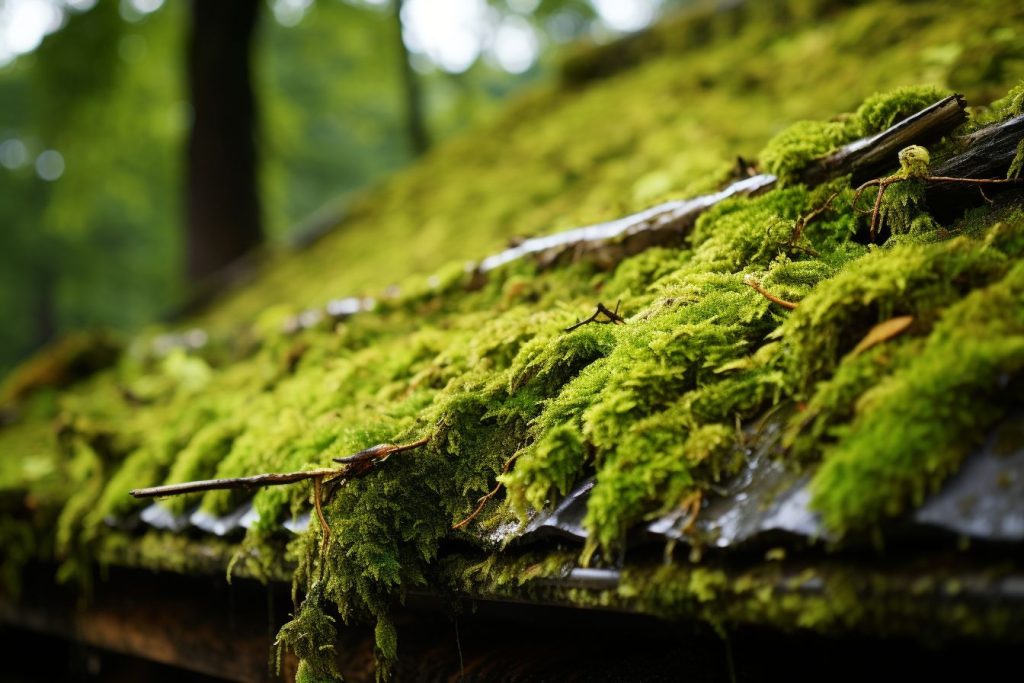Dealing with roof moss can be a challenging task for any homeowner. Left unchecked, this green invader can cause significant damage to your shingles and even lead to leaks. In this article, we’ll explore effective methods for removing moss from your roof and share tips on preventing future growth.
Ready? Let’s climb up that ladder and tackle the problem head-on!
Key Takeaways
- Roof moss can cause damage to shingles, trap moisture, and lead to leaks.
- Manual removal and using a cleaning solution are effective methods for removing roof moss.
- If manual removal or cleaning solutions don’t work, consider seeking professional help.
- Prevent future moss growth by installing zinc or copper strips, trimming tree branches, and performing regular roof maintenance.
Why is Moss Bad for Roof Shingles?
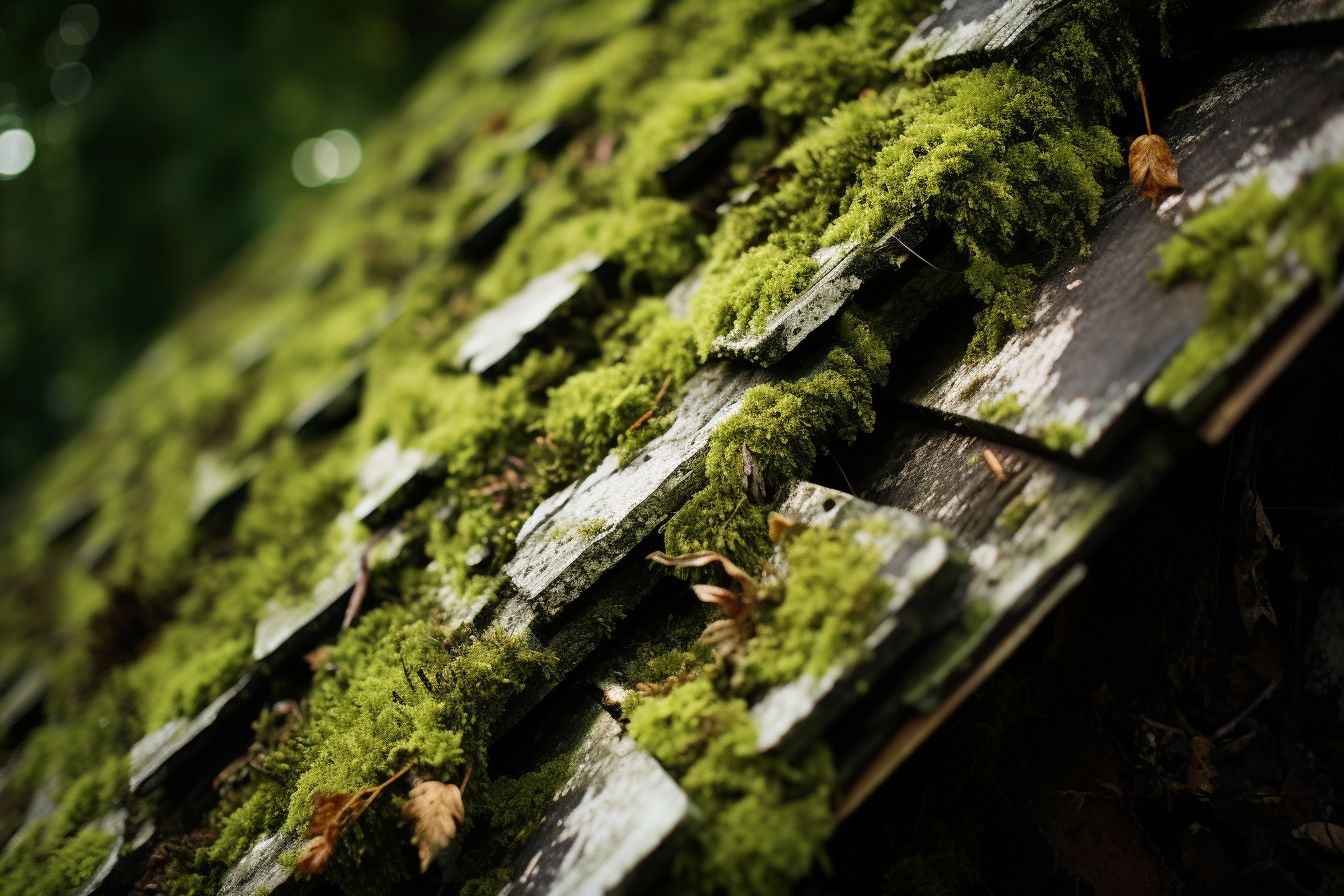
Moss is bad for roof shingles because it can cause damage to the shingles, trap moisture, and potentially lead to roof leaks.
Damage to shingles
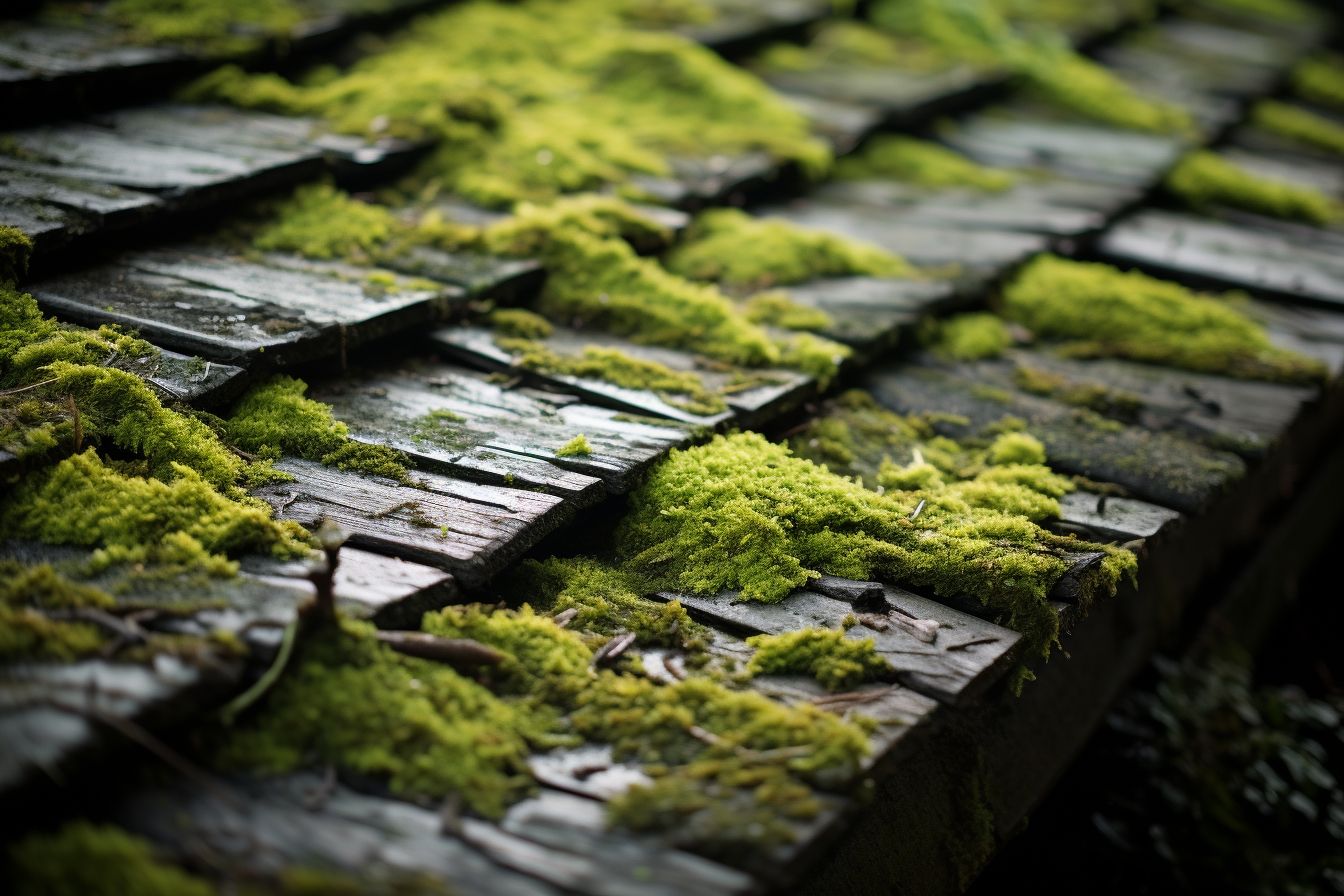
Moss on the roof can cause serious harm to shingles. It strips away their protective oils, making them susceptible to erosion and deterioration. The leading edge of the shingle is often lifted or curled due to moss growth, negatively affecting its performance.
A dense layer of moss retains moisture, creating a damp environment that further accelerates the shingles’ wear and tear process. Moss also has an uncanny ability to lift roofing material, paving the way for water seepage, which considerably amplifies the risk of leaks.
Moreover, asphalt and metal roofs aren’t immune either – moss tightly clings onto these surfaces, promoting water ingress and subsequent damage.
Trapped moisture
Moss thrives in damp conditions and has an uncanny ability to hold substantial moisture. Acting like a sponge, moss absorbs water and retains it on your roof, creating an environment conducive to its proliferation.
Excessive dampness seeps into the shingles, degrading them over time. The constant presence of trapped moisture leads to shingle rot – a serious threat to the structural integrity of your roof.
Prevention is as crucial as cure when dealing with moisture retention caused by moss. A well-ventilated roof doesn’t allow water buildup but keeps the roofing cool, making it inhospitable for moss growth.
Ignoring this issue might lead to severe consequences, such as complete roof deterioration due to unaddressed trapped moisture and potential structural damage caused over time.
Potential for roof leaks
Moss can wreak havoc on your roof, causing immense potential for leaks. The moisture trapped by the moss growth leads to an environment conducive to damage and deterioration. This moisture seeping into your shingles could result in loosening or lifting them off, creating room for water leakage.
If left unattended, these small leaks might cause significant structural damage over time. Even concrete tiles are not immune to this threat; moss roots dig deep, leaving holes where water can find its way through, causing leaks.
It’s not just about flooding but also the gradual erosion compromising the integrity of your home’s shield against weather elements – Your Roof! Regular roof maintenance and timely action in removing moss are crucial in preventing unwanted scenarios and preserving your roof’s longevity.
Removing Moss from the Roof
To remove moss from the roof, you can manually remove it or use a cleaning solution specifically designed for moss removal.
Manual removal
You can use a soft-bristle brush or a putty knife to remove moss from your roof manually. It is important to avoid stepping on the roof while doing so. By physically removing the moss, you prevent it from causing further damage to your shingles and trapping moisture that could lead to leaks.
Dead moss left on the roof can accelerate decay, so thoroughly clean the affected areas using water and a stiff brush or scrub brush. This method allows for the effective removal of moss without harming the roof structure.
Use of a cleaning solution
A cleaning solution is an effective method for removing moss from the roof. One option is to mix one quart of bleach with one gallon of water and 1/4 cup of a heavy-duty cleaner. This solution can help break down the moss, making removing it easier.
It’s important to note that ammonia should not be used as a cleaning solution for roof moss removal, as it can damage the shingles. Instead, apple cider or white vinegar can be used as natural alternatives to kill moss on the roof.
Another plant-friendly option is to create a mixture of dish soap, white vinegar, and water to safely remove moss without harming your roof or surrounding vegetation.
A Comprehensive Guide on How to Deal with Roof Moss
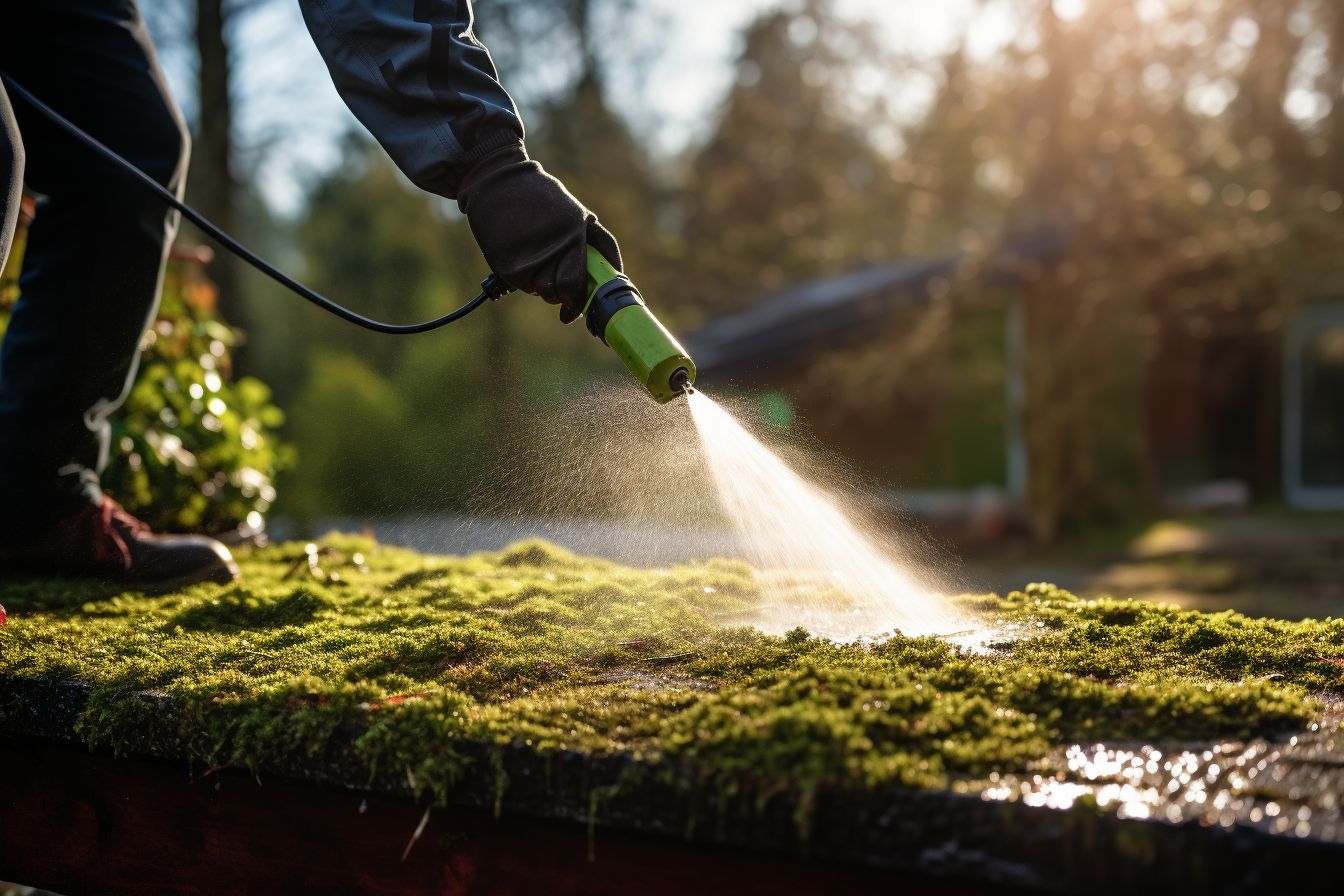
To effectively deal with roof moss, there are several steps you can take. Firstly, manual removal is a simple yet effective method. Using a garden hose with a spray attachment, dislodge the moss from the roof by spraying water at a downward angle.
Be careful not to use too much force, which could damage the shingles. Another option is to use a cleaning solution specifically designed for roofs. These solutions help to kill and remove the moss without causing any stains or damage to your roof or gutters.
If manual removal or cleaning solutions don’t do the trick, you may need to consider professional help for more stubborn cases of moss growth on your roof. Professional roof cleaning services have specialized equipment and expertise that ensures safe and thorough moss removal.
Once you’ve dealt with existing moss on your roof, preventing future growth is important. One way to do this is by installing zinc or copper strips along the ridge of your roof. When it rains, these metals release natural compounds that inhibit moss and algae growth.
In addition, trimming overhanging tree branches can reduce shade and create an environment less favourable for moss growth on your roof. Regular maintenance and cleaning of your roof also play an important role in preventing future moss issues.
By following these steps – manual removal, using cleaning solutions if necessary, seeking professional help when needed, installing metal strips along the ridge line, trimming tree branches, and regular maintenance – you can effectively deal with existing moss on your roof while taking measures to prevent its return in the future.
Preventing Future Moss Growth on Your Roof
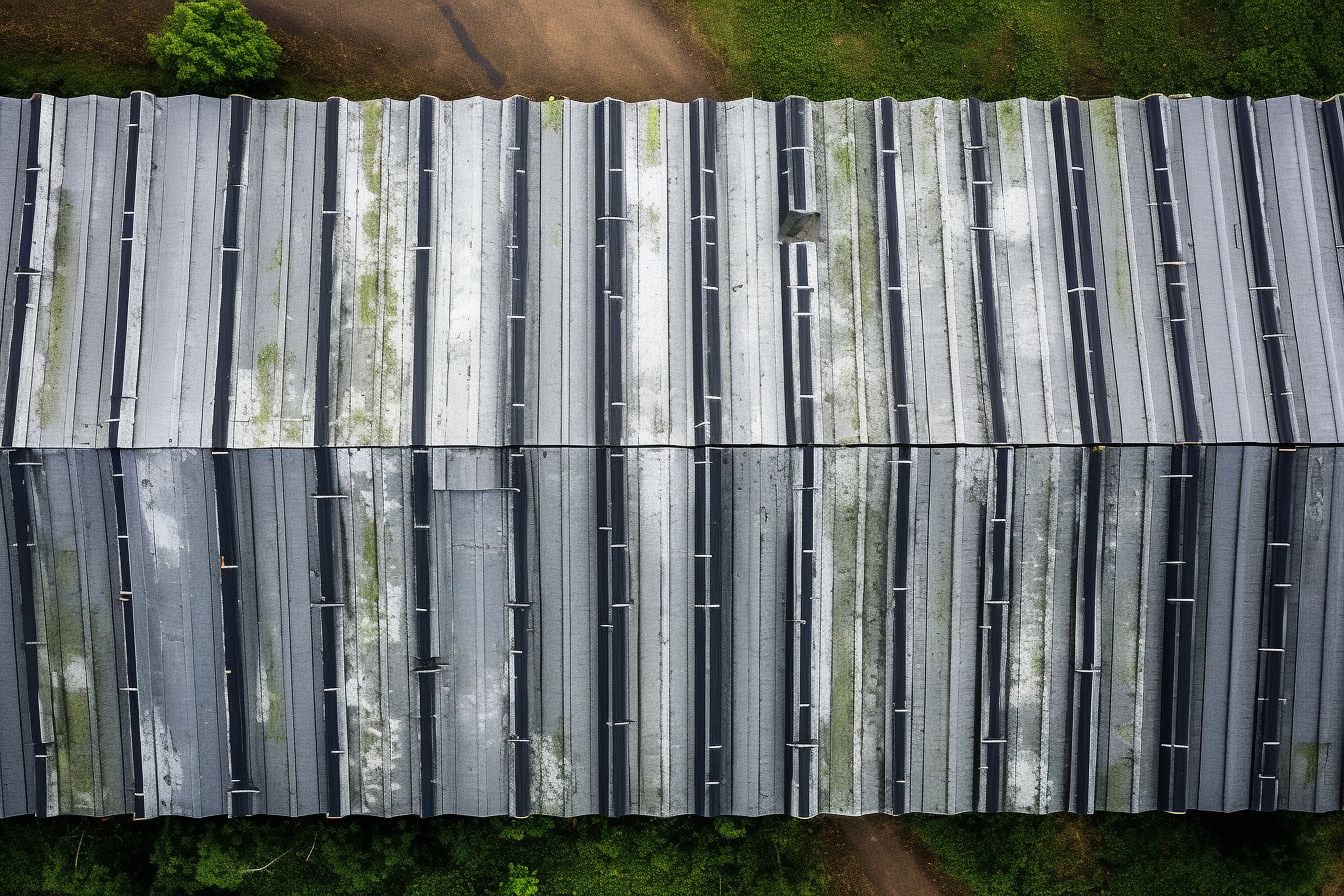
To prevent future moss growth on your roof, install zinc or copper strips, trim overhanging tree branches, and perform regular roof maintenance and cleaning. Don’t let moss damage your roof – learn how to protect it here!
Install zinc or copper strips.
Installing zinc or copper strips under your roof shingles is an effective way to prevent moss growth. When it rains, these strips release a harmless chemical that helps kill moss and lichen.
Zinc strips are believed to be just as effective, if not better, than copper in preventing moss from taking hold on your roof. To ensure maximum effectiveness, multiple layers of zinc strips may be necessary.
The best part is that these strips can be easily installed without nails. Consider using Shingle Shield zinc strips, as they are a popular choice for keeping your roof free from moss and extending its lifespan.
Trim overhanging tree branches.
Trimming overhanging tree branches is an effective way to prevent moss growth on your roof. By pruning back limbs that hang over the roof, you can minimize shade and increase sunlight exposure on the roof surface, making it less inviting for moss to grow.
In addition, trimming branches that drip rainwater or deposit wet leaves onto the roof helps to control moisture buildup, which is a breeding ground for moss. Keeping these branches in check can reduce the risk of moss taking hold and damaging your roof.
Proper tree care and regular maintenance will help maintain a moss-free roof in the long run.
Regular roof maintenance and cleaning
Regular roof maintenance and cleaning are crucial in preventing future moss growth on your roof. By regularly maintaining and cleaning your roof, you can prevent the buildup of debris that provides a breeding ground for moss spores.
This helps protect your roof shingles from the harmful effects of moss growth, such as damage, trapped moisture, and potential leaks. Make it a part of your routine to remove any leaves, branches, or other debris from your roof and clean it periodically to maintain its cleanliness and integrity.
Doing so ensures that your roof remains in good condition while minimizing the risk of moss buildup.
Conclusion
In conclusion, dealing with roof moss is essential for the health and longevity of your roof. You can eliminate this green menace by removing moss manually or using a cleaning solution.
Additionally, taking preventative measures such as installing zinc or copper strips, trimming tree branches, and regular maintenance will help prevent future moss growth on your roof.
Don’t let moss take over – take action to protect your roof today.
FAQs
1. What causes moss to grow on roofs?
Moss typically grows on roofs due to moisture, shade, and lack of sunlight.
2. How can I remove moss from my roof?
To remove moss from your roof, use a mixture of water and bleach or a commercial moss remover, followed by gentle scrubbing with a brush or broom. Be careful not to damage the roof surface while cleaning.
3. Can I prevent moss from growing on my roof?
You can prevent moss growth by trimming tree branches that provide excessive shade and improve sunlight exposure on the roof. Additionally, keeping the roof clean and debris-free will help discourage moss growth.
4. Is hiring a professional to deal with roof moss necessary?
While hiring a professional is not always necessary, it may be beneficial if you are unsure about safely accessing your roof or if the infestation is extensive. Professionals have the knowledge and equipment to remove and prevent future moss growth effectively.
5. How often should I check for roof moss?
It’s advisable to check for any signs of roof moss at least once yearly, ideally during springtime when conditions are favourable for its growth. Regular inspections will help detect any early signs of infestation so they can be addressed promptly.

